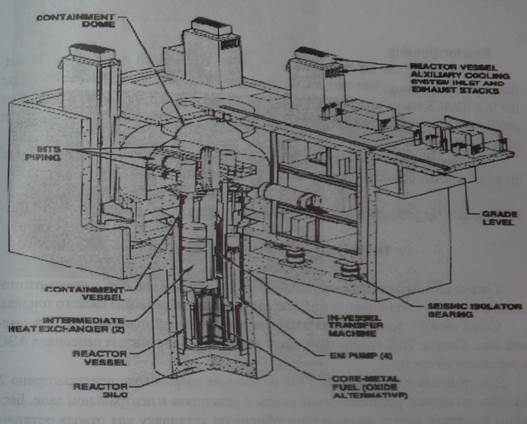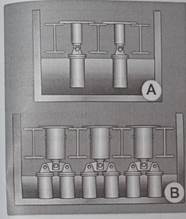Introduction to the ALMR/PRISM
The acronym ALMR stands for Advanced Liquid Metal Reactor. Their design is called the PRISM. PRISM stands for Power Reactor Innovative Small Module. The ALMR (or PRISM) is a fast reactor but, unlike most fast reactors, it is not designed to breed significant amounts of Plutonium (though the core could be modified to optimize this).
Each plant site contains three power blocks. A power block consists of three of these modular reactors, thus the use of the word Module in PRISM. Therefore, each reactor site contains nine reactors. Each reactor produces 160 MWe of power. A reactor producing this amount of power is considered to be small thus, the use of the word Small in PRISM. Each power block produces 480 MWe of power. The steam generated by the three reactors in a power block passes to a common steam turbine to generate electricity.
Thus, the total plant produces 1440 MWe of power from three steam turbines.

A utility can choose to have less than three power blocks on a plant site or they can start with one and add-on power blocks as their demand increases. Even more significant to the economics of the utility is the fact that each reactor is liscenced separately and that reactors on a power block can start producing electric power before the other reactors are even built.
The last PRISM innovation is the idea of the reactor components being built in a factory and shipped to the plant site; even the large reactor vessel. Currently, components are constructed at the plant site but, with this new approach, factory standards can be assured before the components are shipped.

Reactor Housing
Тhе ALMR reactor modules themselves are located beneath ground level. In fact the only distinguishing characteristic that identifies the ground as being a reactor site are the four RVACS stacks rising from the ground. This low profile will hopefully improve public opinion about nuclear reactors. They expect the old proverb, "Out of sight, out of mind," to apply.
Even though the reactor is below grade, it still has a fully secure containment and the unusual stacks denote a unique feature of this reactor.
V. Translate the following information into English:
ХРАНЕНИЕ ЯДЕРНОГО ТОПЛИВА
Свежие тепловыделяющие кассеты (ТВК), поступившие на АЭС с завода-изготовителя, хранятся в герметичных контейнерах на объектовом складе свежего топлива.
Склад свежего топлива располагается выше нулевой отметки в незатопляе-мой зоне. Свежие ТВК в радиационном отношении безвредны для персонала АЭС и окружающей среды.
Для хранения отработавших ТВК на каждом энергоблоке предусмотрено 2 бассейна выдержки, расположенных рядом с реактором в центральном зале. Бассейны выдержки имеют насосно-теплообменную установку для отвода остаточных тепловыделений в отработанном ядерном топливе. ТВК хранятся в герметичных пеналах подуровнем воды. Емкость обоих бассейнов выдержки обеспечивает возможность одновременного хранения полной топливной загрузки реактора, что соответствует количеству выгружаемых из реактора ТВК за четыре года работы на полной мощности.
Ориентировочное время выдержки ТВК в бассейне выдержки составляет около двух лет. По прошествии этого периода осуществляется перевод ТВК в хранилище отработанного ядерного топлива.
Перед транспортировкой топливная кассета отделяется от подвески с помо-
щью механизма резки. Подвески после дезактивации направляются на повторное пользование, а топливные кассеты загружаются в охлаждаемый контейнер специальиого вагона-контейнера. В приемном отделении хранилища, куда подается вагон -контеинер, топливные кассеты помещаются в пеналы и поступают на длительное хранение в заполненные водой отсеки хранилища.

CHEPTER VIII
